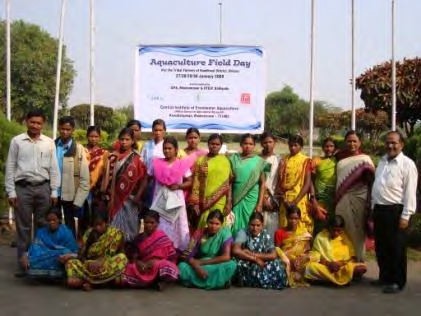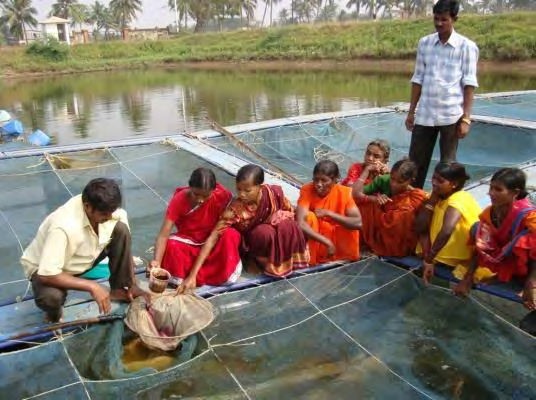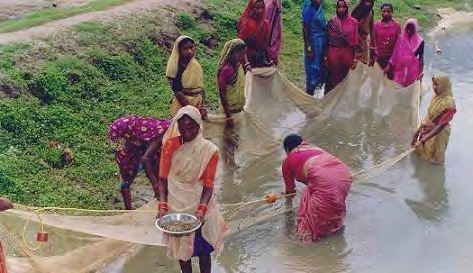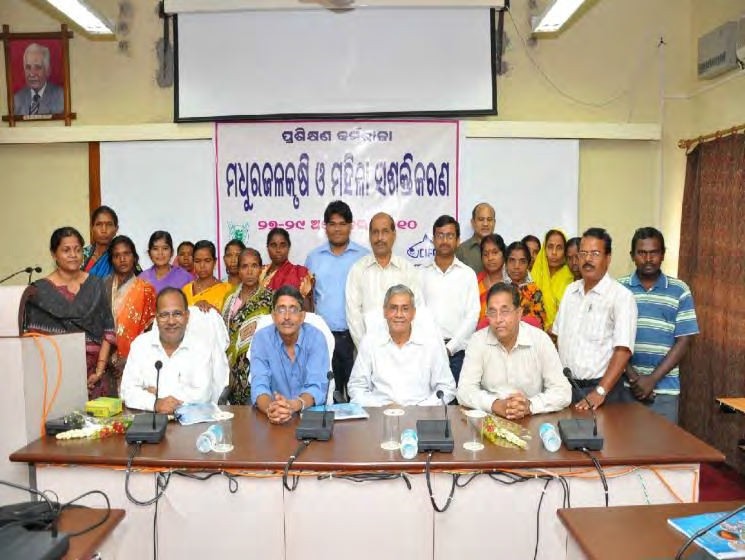Rural Aquaculture
Aquaculture contributes to poverty alleviation as it provides employment to millions of people, both in the sector itself as well as in support services. Aquaculture is the farming of aquatic organisms including fish, molluscs, crustaceans and aquatic plants. Farming implies some form of intervention in the rearing process to enhance production such as regular stocking, feeding and protection from predators etc. Rural aquaculture as a weapon to fight poverty and reduce inequality has received renewed attention in recent years. It depends largely on natural food,which is increased over baseline levels by fertilization and/or use of supplementary feed to complement natural food. Supplementary feed with traditional fish feed material such as groundnut cake, mustard oil cake and rice bran in dough form would enhance fish yield substantially.
Rural Aquaculture
Rural aquaculture pertains to the farming of aquatic organisms by small-scale farming house hold or communities, usually by extensive or semi-intensive low-cost production technology appropriate to their resource base. In rural aquaculture there is low level of fish production for household use and family income (Choudhury,1997). It’s production and income potential has largely remained undocumented.The resource-poor base of most farms requires off-farm agro industries inputs to intensify production. This implies use of mainly inorganic fertilizers rather than formulated feed to provide low market value produce affordable to poor consumers. Aquaculture growth can be accelerated in 2 ways – by increasing the area devoted to aquaculture and by intensifying production in existing aquaculture areas. Horizontal expansion of agricultural land is limited. In contrast there is considerable potential to increase area under aquaculture. Vast areas remain to be utilized for aquaculture. Aquaculture may use swamps, saline soils, mangroves that are otherwise, unsuitable for agriculture. It may also use inland aquatic resources such as natural and man made lakes, reservoirs, rivers etc. (Choudhury, 1997).
Researchersin India and elsewhere have demonstrated the impact of rural aquaculture on thelives of poor. In terms of providing nutritious food (fish being the cheapestanimal protein) and creating employment opportunities aquaculture interventionshave proved to be quite useful. It is important that untapped water resourceslying in rural areas are brought under scientific fish farming. Promotion of ruralaquaculture is often plagued by several hindrances, important among these are -non-availability of seed, lack of skill, multiple use of waterbodies, marketingrelated problem etc. It is essential that farmers are provided with easy accessto inputs, skill training and marketing arrangement. This would enable thefarmers to make use of the water resources towards ensuring their nutritionalas well as livelihood security.
CIFA’s involvement in promoting rural aquaculture
The Central Institute of Freshwater Aquaculture, Bhubaneswar a constituent ofIndian Council of Agricultural Research (ICAR) has been actively engaged in promoting scientific aquaculture in thecountry since its inception. The CIFA erstwhile Freshwater Aquaculture Researchand Training Centre as an unit of Barrackpore based Central Inland FisheriesResearch Institute was devoted to imparting training in various aspects of freshwater aquaculture. Besidesconducting refresher courses for state line department officials the Institute impartedneed based skill training to farmers and entrepreneurs. The Institute hasconducted 406 training programmes till 2006-07 and a total of 7359 persons arebenefited. The Institute also operated several funded projects in differentparts of the country towards dissemination of aquaculture technologies. Aglimpse of recently operated projects is presented below-
- Women in Fisheries in Orissa, sponsored by UNIFEM (United Nations Development Fund for Women). The project was launched in 1992 and 300 tribal women from three backward districts of Orissa were benefited.
- The Institute Village Linkage Project through Technology Assessment and Refinement was operated during 1997-2001 in eleven villages around CIFA. Technologies of carp breeding, seed rearing and table size fish production were successfully transferred among the farmers.
- The Institute was also involved in the project “Management of Coastal Agroecosystem affected by Supercyclone’’ towards rehabilitation of cyclone (1999) affected people in Ersama and Astarang blocks of Orissa. Pond renovation, desilting, stocking of quality fish seed and other measures were adopted as a means of strengthening livelihood of farmers.
- Jai Vigyan National Science and Technology Mission. The project was operated during 2000-04 for enhancing freshwater fish production towards ensuring household food and nutrition security in Kalahandi and Bastar.
- The project ‘Economic and livelihood development of SC/ST population through freshwater aquaculture technologies was operated during 2006-09. Carp seed production, carp culture and integrated fish farming were promoted in two tribal dominated districts in Odisha viz., Keonjhar and Kendrapara.
- An NAIP sponsored project ‘Sustainable livelihood improvement through integrated freshwater aquaculture, horticulture and livestock development in Mayurbhanj, Keonjhar and Sambalpur districts of Odisha’ operated during 2009-12. An Integrated development approach was adopted involving freshwater aquaculture, poultry and horticulture. Four thousand farm families in 3 districts in Odisha are benefited through this project.
- The project ‘Carp seed production in mobile hatchery and rearing for livelihood development for SC/ST communities in selected districts of Odisha’ sponsored by DBT was operated in two backward districts viz., Mayurbhanj and Nayagarh during 2009-12.
- The project ‘Transfer of technology of composite carp culture through demonstration among SC/ST women in Boudh and Purulia’ sponsored by DST was operated during 2009-12. Over 200 tribal women in two districts are benefited through this project.
- Productivity and production enhancement of freshwater ponds through BMP and aquaculture for livelihood development of the Aila affected ST/ST communities of islands of the Sundarbans, West Bengal , sponsored by DBT was operated during 2016-19.
- Carp seed production and integrated fish farming technology for livelihood development of Phailin affected tribal farmers of Ganjam district, Odisha, sponsored by DST was operated during 2016-19.
- Upliftment of tribal community through scientific adoption of aquaculture technologies for the improvement of their livelihood and socio economic status in selected districts of Andhra Pradesh sponsored by DBT was operated during 2016-19.
- The project “Scheduled Caste Sub Plan” is being operated since 2019 for livelihood strengthening of SC beneficiaries through promotion of Aquaculture, Animal Husbandry, Apiculture and other enterprise ensuring direct economic gain to SC community in Odisha, Punjab, West Bengal, Andhra Pradesh and Tamilnadu states involving over 900 beneficiaries.
- The project “Tribal Sub Plan” is being operated since 2018 in four aspirational districts (West Singbhum, Jharkhand, Nawrangpur, Odisha, Gajapati, Odisha, Koraput, Odisha) with sizeable tribal population and various enterprises are being promoted. A total of 1334 people are benefitted through this project.
Besides the Instituteis engaged in development of freshwater aquaculture in North East region of the country. The Institute through its four regional research centres located at Rahara (West Bengal) ; Vijaywada (Andhra Pradesh ) ; Bangalore (Karnataka) and Anand ( Gujarat) is popularizing aquaculture technologies across India.
Women in Aquaculture
Involving women in aquaculture
–33 years of ICAR-CIFA’s contribution
Empowerment of women is a multifaceted and multi-dimensional concept. It is a process through which women gain greater access to resources and also gain control over decision-making. Empowerment indicates a shift from the position of enforced powerlessness to greater self-reliance. Of late women’s contribution in aquaculture sector have become the subject of global consideration. Involvement of rural women in aquaculture production activities including composite carp culture, seed rearing and integrated fish farming has been advocated for their socio-economic upliftment and generation of self-employment. However, lack of focus coupled with cultural and social constraints limit participation of women in training and empowerment. Appropriate methods in aquaculture extension coupled with appropriate technologies can draw rural women towards aquaculture practice in a sustainable way.
The Central Institute of Freshwater Aquaculture (CIFA), Bhubaneswar has operated several transfer of technology projects during the last 33 years. While few projects were exclusively benefitted farm women others adopted substantial number of women as beneficiaries. A brief account of the transfer of technology projects that have contributed to women empowerment is given below.
1987: ‘S & T for Women’ was operated in five villages involving fifty farm women in fish farming. Successional aquaculture’ evolved for steady stream of income round year.
1992: Women in Aquaculture (in collaboration with XIM, Bhubaneswar) benefitted 300 tribal women from three backward districts of Orissa. Involvement of women in aquaculture proved to be beneficial in improving socio-economic status. Indian Major carp spawn were reared in seven small backyard and kitchen ponds measuring 0.05 – 2.0 ha. water area in four villages of Keonjhar district of Orissa by tribal women.
1999: Institute Village Linkage Programme (IVLP) was operated in eleven villages around CIFA for technology assessment and refinement through on farm research. Common carp breeding and grow out culture was promoted among women. Through this programme, women demonstrated that if a supportive environment is provided, seed production activity can be easily undertaken by them.
1999: Aquaculture development in NEH states. Aquaculture development work was taken up in Assam, Arunachal Pradesh, Manipur, Meghalaya, Mizoram, Nagaland and Tripura. Grow out carp culture, integrated fish farming, ornamental fish breeding and culture technologies were demonstrated. Hatcheries for carps and magur were established. Pilot scale demonstration on cage culture conducted. A large number of farm women were benefited through this intervention.
2000: Under Jai Vigyan National Science and Technology Mission, enhancing freshwater fish production towards ensuring household food and nutrition security was the focus. Potential of freshwater aquaculture in non-conventional areas viz., tribal, hilly and backward areas explored. A group of tribal women from Burumpal, Bastar Burumpal, harvested around 2.0 ton of fish from 1.4 ha waterbody, where nothing could be produced earlier.
2006: Economic and livelihood development of SC/ST population through freshwater aquaculture technologies was operated in two tribal dominated districts in Odisha Keonjhar and Kendrapada. Technologies i.e., Carp seed production, carp culture and Integrated fish farming were promoted. Average fish yield in adopted ponds in Keonjhar increased four folds. At Tanar, Kendrapada a women SHG became successful in fish breeding.
2009: Sustainable livelihood improvement through integrated freshwater aquaculture, horticulture and livestock development was operated in Mayurbhanj, Keonjhar and Sambalpur districts of Odisha in a consortia mode. Central Horticultural Experimental Station; Central Avian Research Institute and Centre for Development Research and Training were the consortia partners. 3000 farm families were benefitted. An Integrated development approach was adopted involving freshwater aquaculture, poultry and horticulture. Women beneficiaries were actively involved in fish culture, ornamental fish breeding and culture, backyard poultry bird rearing and kitchen gardening. Several women SHGs were organized to adopt farm based vocations for livelihood development.
2009: Carp seed production in mobile hatchery and rearing for livelihood development for SC/ST communities was implemented in two backward districts viz., Mayurbhanj and Nayagarh. Ten FRP carp hatchery have been installed and operated for carp seed production. At Khanguri, Nayagarh a women SHG successfully involved in carp breeding and fish seed production.
2009: Under the project ‘demonstration of FRP carp hatchery techniques and environmental management leading to fish seed production and rearing through women participation in Khurda’ sixty women belonging to 4 SHGs were adopted. Carp breeding, seed rearing, grow out culture and integrated farming technologies demonstrated. At Kaijanga the SHG took seven breeding in the year 2010 and 0.46 million spawn produced using FRP hatchery. Grow out carp culture as well as fish-cum-horticulture integrated farming system demonstrated.
2009: Transfer of technology of composite carp culture through demonstration among SC/ST women in Boudh and Purulia district. The project was carried out in Kashipore block of Purulia (West Bengal) and Kantamal block of Boudh (Odisha). 200 tribal women in two districts are benefitted. The mean fish yield of adopted ponds rose to 795.98 kg/ha in 2010-11 from pre-adoption production level of 378.79 kg/ha in 6-8 months. Average income from the adopted ponds was worked out to be Rs 42513.47 per ha.
2011: CIFA played an instrumental role in developing two ornamental fish villages in 2011. Ornamental fish rearing (Black molly, Red molly, Angel fish, Gold fish etc.) in the backyard has caught up with the women in Landijhari (Deogarh district) with as many as 60 cement tanks being used for this purpose. The local fishery officer initiated this new way of income generation among the women. The Agricultural Technology Management Agency (ATMA) also pitched in by providing financial assistance for construction of rearing tanks. Capacity building and exposure was provided by the institute. The scientists of Krishi Vigyan Kendra, Deogarh popularized the new vocation in the village by organizing awareness camps (Nath et al 2012). With all the families engaged in rearing ornamental fish the village came to be known as ‘ornamental fish village’. Another ornamental fish village has also been developed recently at Sarauli in the same district with the partnership of ICAR-CIFA, ATMA and State Fisheries Department to promote livelihood development of women SHGs.
2011: Barakhandapat SHG having 10 women members in Jodichatara village of Patna cluster in Keonjhar district of Odisha was introduced to ornamental fish farming. A combined effort was made by NAIP and ICAR-CIFA to improve the sustainable livelihood of the poor women. Skill training, exposure visit and demonstration were organized in order to encourage them to take up ornamental fish farming. For marketing a linkage was developed with Aqua World shop. The expected revenue from the unit is estimated at Rs.12,000/unit/year during the first year (Swain et al. 2011).
2012: Under the project “Mainstreaming gender concerns in freshwater aquaculture development- an action research”, 160 women belonging to Khordha and Puri district were provided skill training in fish seed rearing, composite carp culture and value addition technologies. Smt. Ranulata Bhoi, an industrious entrepreneur and self- reliant woman from a rural village, Paribasudeipur of Balianta block, Khordha district of Odisha has been successful in producing fish hydrolysate. Presently she is producing 200 litre of this bio-fertilizer annually and earning an income of Rs. 16000/- per annum. She was felicitated by different organisations such as ICAR-CIFA, Bhubaneswar, Doordarshan and ‘Yes We Can’ – a volunteer organization, Odisha.
2016: Farmer FIRST project is being operated in 4 villages of Khordha district which involved more than 400 beneficiaries. Scientific carp culture, carp seed rearing and minor carp culture was promoted in the adopted villages. Training was imparted on improved practices of aquaculture. Species diversification by incorporating minor carp in backyard pond was popularized to attract women towards aquaculture.
During the past three decades considerable amount of attention has been paid by CIFA towards socio-economic development of women. A wide range of aquaculture technologies e.g., carp breeding, seed rearing, composite culture, ornamental fish breeding and culture, integrated fish farming etc. have been popularized for adoption by women. Recent years have also witnessed increased number of women participating in CIFA’s training programme as well as visiting the Institute for seeking information on aquaculture technologies. These initiatives also helped bringing them closer to Govt. establishments, Banks etc. Office bearers of SHGs have to deal with management and financial aspects of pond management viz., purchase of inputs – fingerling, lime, feed, fertilizers etc. and selling table fish. Additional income accruing from fish culture has also resulted in improved social status of women. Aquaculture is increasingly being recognised as a tool for empowering women even in most difficult areas. If women take up fish culture as a micro-enterprise it will lead to improved household nutrition, food security, better income and enhanced employment opportunity
It is time that we seek to realize the full potential of women in aquaculture, mainstream them in development activities and provide all support and strength for their enhanced productivity. In order to ensure that women utilize their full potential in profitable activity like fish farming it is necessary that they are provided with capacity building support, which eventually will lead to their empowerment. The mechanism of linking the stakeholders with credit, technology, infrastructure, training and trade has to be built in to the project in order to ensure livelihood and economic security of the rural women.
Compiled by: H.K. De, G.S. Saha, A. S. Mahapatra and N. Panda




